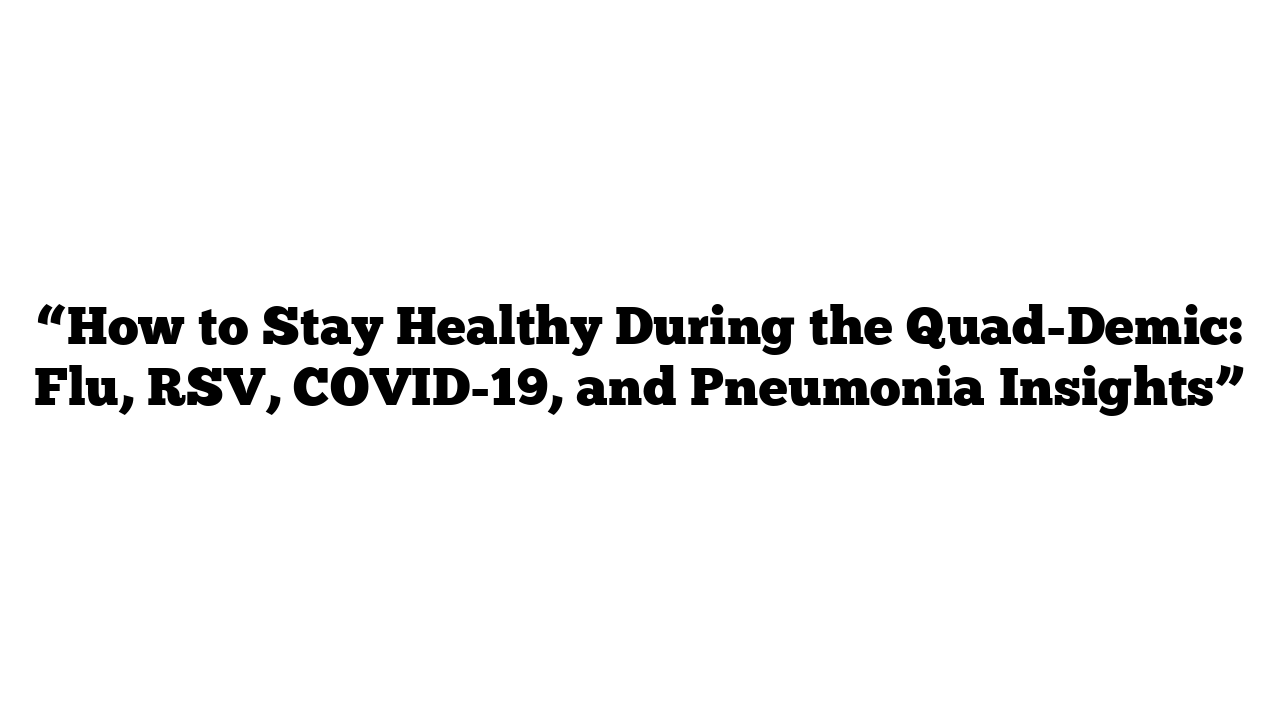The Quad-Demic: A Rising Threat to Public Health
Respiratory illnesses have surged in the U.S., with health experts warning about the simultaneous rise of flu, RSV, COVID-19, and pneumonia cases. This situation, termed the “quad-demic,” has overwhelmed hospitals and raised public concern.
In this article, we’ll explore the quad-demic, its symptoms, how these viruses spread, and prevention strategies to keep you and your family safe.
What Is the Quad-Demic?
The quad-demic refers to the convergence of four respiratory illnesses:
- Influenza (Flu)
- Respiratory Syncytial Virus (RSV)
- COVID-19
- Pneumonia
This unique overlap creates challenges for healthcare systems and increases the risk of severe illness, particularly in vulnerable populations like children, the elderly, and those with underlying conditions.
Why Are Cases Surging?
- Relaxed Public Health Measures: Reduced mask use and social distancing have allowed these viruses to spread more easily.
- Low Immunity: Many people missed routine vaccinations during the pandemic, lowering herd immunity.
- Overlapping Seasons: These viruses typically peak in winter, creating a perfect storm for simultaneous outbreaks.
Breaking Down Each Virus
Influenza (Flu)
The flu is a seasonal respiratory virus that causes symptoms like fever, cough, and fatigue. According to the CDC, flu activity remains high, with hospitalizations climbing significantly this winter.
RSV (Respiratory Syncytial Virus)
RSV primarily affects young children and older adults. Symptoms include wheezing, coughing, and difficulty breathing. Severe cases can lead to bronchiolitis or pneumonia, especially in infants.
COVID-19
COVID-19 continues to mutate, with new variants emerging that evade immunity from previous infections or vaccines. Symptoms often overlap with flu but can include loss of taste or smell.
Pneumonia
Pneumonia can be caused by bacteria, viruses, or fungi, often as a complication of the flu or COVID-19. Symptoms include chest pain, shortness of breath, and fever.
Symptoms to Watch For
The symptoms of these illnesses can overlap, making it challenging to identify the cause.
Common Symptoms
- Fever and chills
- Cough (dry or wet)
- Fatigue
- Shortness of breath
- Congestion
Red Flags
Seek medical attention if you experience:
- Severe difficulty breathing
- Persistent high fever
- Chest pain
- Blue-tinged lips or face
How the Quad-Demic Affects Healthcare Systems
Hospitals across the U.S. are reporting high patient volumes due to the quad-demic. In places like Philadelphia, pediatric units are particularly strained, according to the Philadelphia Inquirer.
Impact on Healthcare Workers
- Increased workloads
- Shortages of beds and medical supplies
- Delayed care for non-respiratory illnesses
What This Means for You
Avoid unnecessary emergency visits unless symptoms are severe, as overcrowding could delay critical care.
How to Protect Yourself During the Quad-Demic
1. Get Vaccinated
Vaccination remains the most effective way to prevent severe illness from the flu and COVID-19. Discuss with your doctor if the RSV vaccine or pneumonia shot is recommended for you.
2. Practice Good Hygiene
- Wash hands frequently with soap and water for at least 20 seconds.
- Use hand sanitizer with at least 60% alcohol when washing isn’t an option.
3. Wear Masks in Crowded Places
Masks are effective at reducing the spread of respiratory droplets, particularly in high-risk settings like public transit or hospitals.
4. Boost Your Immune System
- Eat a balanced diet rich in fruits, vegetables, and whole grains.
- Stay hydrated and get at least 7–8 hours of sleep per night.
5. Avoid Close Contact with Sick People
If someone in your household is ill, isolate them and disinfect frequently touched surfaces.
Prevention Tips for Children
Children are especially vulnerable to RSV and flu. The News Nation Now report emphasizes the importance of teaching kids proper hand hygiene and avoiding crowded indoor spaces.
Vaccination for Kids
- Ensure your child is up to date on their flu shots.
- COVID-19 vaccinations are now available for children as young as six months.
When to Seek Medical Help
Mild Symptoms
Most mild cases can be managed at home with rest, fluids, and over-the-counter medications.
Severe Symptoms
Visit a healthcare provider immediately if symptoms worsen, especially if:
- Fever persists for more than three days.
- Breathing becomes difficult.
- Symptoms of dehydration appear (e.g., reduced urine output, dry mouth).
The Role of Public Awareness
Raising awareness about the quad-demic is critical to reducing its spread. Local news outlets like Messenger News have emphasized the importance of community-level prevention efforts.
What You Can Do
- Share accurate information on social media.
- Support local healthcare initiatives.
- Stay informed by visiting trusted sites like medicaltimes.io.
FAQs About the Quad-Demic
1. What is the quad-demic?
The quad-demic refers to the simultaneous outbreaks of flu, RSV, COVID-19, and pneumonia.
2. Who is most at risk?
Children, older adults, and people with weakened immune systems are most vulnerable.
3. Can I get all four illnesses at once?
While rare, co-infections are possible, which can lead to severe complications.
4. How can I tell which illness I have?
A healthcare provider can perform tests to determine the cause of your symptoms.
5. Are vaccines effective against the quad-demic?
Vaccines for flu, COVID-19, and RSV significantly reduce the risk of severe illness.
6. Should I wear a mask again?
Yes, especially in crowded or high-risk settings.
7. Can healthy people get severe cases?
Yes, even healthy individuals can develop complications, though the risk is lower.
8. How long will the quad-demic last?
Respiratory viruses typically peak during winter and decline in spring.
9. Are schools safe during the quad-demic?
Schools are implementing hygiene measures, but vaccination and mask use remain crucial.
10. Where can I find reliable updates?
Visit trusted sources like the CDC, local health departments, and medicaltimes.io.
